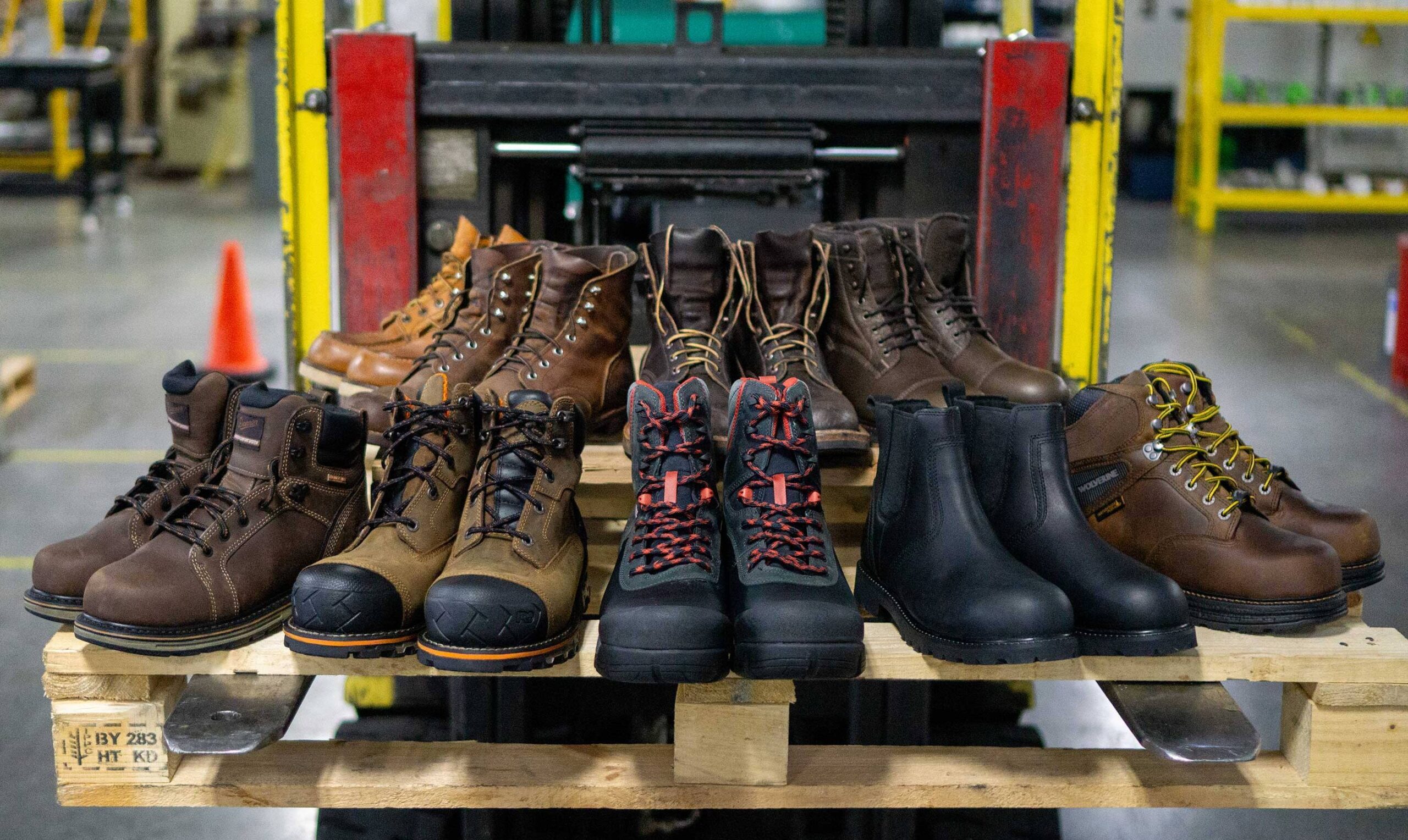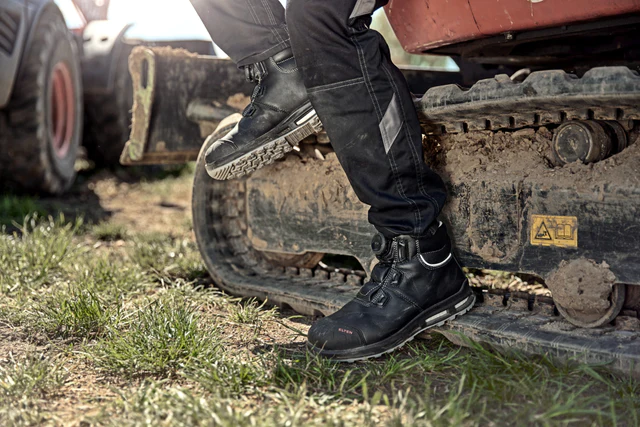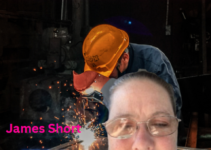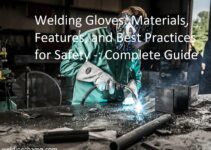Are you a professional welder looking for the perfect pair of welding boots? You need protection, comfort, and durability when it comes to your feet.
Here’s everything you need to know to help you choose the best welding boots for your safety and performance.
The job of a welder can be dangerous if proper safety measures are not followed, and part of this is the right kind of boots. Welding calls for long hours on the job standing on concrete or other hard surfaces that can cause injuries or discomfort. As a result, it is essential to choose welding boots that provide safety, comfort, and durability no matter what kind of environment you are working in.
The materials used to make welding boots can greatly impact their level of safety. Leather is highly recommended as it is sturdy and contains natural insulation against heat splashes. Furthermore, synthetic materials such as nitrile rubber can increase a boot’s durability and water-resistance. Steel toecaps offer protection against dropping tools or heavy materials, while shock-absorbing soles help prevent physical injuries from long hours on the job walking around heavily vibrating machinery or uneven floors. Finally, always look for boots with good tread to ensure better grip when using ladders or moving around slippery surfaces such as oil spills in shipyards or on construction sites.
In addition to safety features, it is important to consider comfort when choosing welding boots. Soft linings might not seem durable but they will help cushion your feet after long hours in the same pair of shoes. Moreover, insoles made from breathable materials will also contribute towards reducing fatigue caused by heat buildup as well as providing some extra cushion for your feet throughout the day.
Finally, you should choose welding boots based on your work environment and assess their entire lifespan prior to making your purchase decision: when searching online look for user reviews from people who have actually tested them out in the field instead of judging solely based on looks. This way you can purchase a pair that meets all criteria (safety, comfort and durability) without spending an arm and a leg!
Traditional Welding Lenses
Traditional welding lenses are the most common type, offering a wide variety of advantages to welders. The most important benefit of traditional welding lenses is that they offer more comfortable eye protection compared to other kinds, as they have been designed to fit on a welder’s head more securely and firmly.
Traditional welding lenses are also typically available in a variety of tints, providing welders with options to choose from when shopping for the right lens. Traditional welding lenses are made from materials like glass and plastic, usually in combinations such as glass/plastic or plastic/glass. This helps ensure that the lens is incredibly strong and resistant to corrosion, thus giving it optimum longevity for long-term wear on the job site.
Additionally, these types of welding goggles provide flexibility and comfort due to their adjustable frame sizes. They also allow for great ventilation so that you can wear them comfortably during your welding job without unnecessary sweating.
Finally, traditional welding lenses are specifically designed with certain areas darkened or tinted in order offer maximum protection from UV rays and light exposure caused by the welding torch’s flame when working on metal pieces for longer periods of time. This unique design will not only protect your eyes from light exposure but also reduce eyestrain that can be caused by staring at metal pieces constantly over an extended period of time while working on them.
Explanation of traditional welding lenses and how they work
A welding lens is a specialized type of filter made to protect welders from eye damage caused by exposure to ultraviolet and infrared light generated by electric arc welding processes. They are worn with a full face shield and hard hat to provide complete protection for the eyes, face, and head. The lens is also designed to protect against intense bursts of sparks and molten metal in projects such as casting and forging.
Traditional welding lenses are manufactured with dyed glass or plastic filters composed of multiple layers fused together. The layers block the potentially damaging spectrum of UV and IR radiation while allowing visible light to pass through, allowing the welder to see clearly while working. The shade they emit ranges from #3 (dark) to #14 (very dark). A darker shade is recommended when welding at higher temperatures or when working with higher amperage because it provides more protection from intense radiation levels.
Some modern lenses utilize liquid crystals instead of traditional filters in order to provide additional protection against variable light levels encountered during most types of welding applications including sheet metal, heavy plate work, and mig/tig welding operations. Liquid crystal technology also allows eyeshields to be stacked or layered for even greater eye protection than traditional lenses can provide.
Regardless of which type they use, all welding lenses should be used in conjunction with a full-face shield in order to comply with safety regulations set forth by OSHA (Occupational Safety & Health Administration). This will ensure that your eyes are adequately protected against hazardous light levels while you work – helping you stay safe, productive, and comfortable on the job!
Advantages and disadvantages of traditional welding lenses
Traditional welding lenses are well-known in the welding industry for their high level of protection, durability, and comfort. However, they also come with a few drawbacks that must be considered when deciding if this style is the right choice for your needs.
Advantages: Traditional welding lenses provide substantial protection for the eyes as well as blocking out UV rays. They are scratch-resistant and long-lasting, meaning they can take a lot of wear and tear without compromising protection. Additionally, they allow more visibility and their curved design provides an excellent fit with helmets.
Disadvantages: Unfortunately, traditional welding lenses are not suitable for use with auto-darkening helmets. Additionally, they often fog up easily due to heat while working under a helmet, making it difficult to do precision work. Furthermore, due to their large design they may not be comfortable or practical to use when out in the field or working in tight spaces.
Auto Darkening Welding Lenses
Auto darkening welding lenses are a modern testament to the continual advances in safety and technology for welders. This type of helmet features a self-tinting lens that can detect the arc light emitted from welding, allowing the welding helmet to darken rapidly during exposure. An adjustable shade range ensures that you are always at the optimal level of protection depending on the job.
Welding helmets with auto-darkening lenses should also have a large viewing area so you can have full vision when working. Many modern helmets even include faster darkening speeds compared to standard lenses, making them more efficient and more comfortable when used for extended periods of time. Auto darkening welding lenses provide versatility and convenience, making them popular among professional welders who need top quality equipment.
Explanation of auto darkening welding lenses and how they work
Welders must wear specially designed welding helmets for safety, comfort, and durability on the job. Auto darkening welding lenses are becoming increasingly popular as they offer protection from the intense heat and light of welding arcs while also providing a window to view the weld through. Through the use of special sensors and compounds, auto darkening lenses are able to detect an arc and then quickly darken in order to provide the welder with up to 11 levels of eye protection.
Auto darkening welding lenses work by using sensors that detect when an arc is struck and then activate a solenoid coil mechanism which causes a blackout shield over the window lens. This blackout shield is made out of a special type of glass that allows visible light in but blocks out ultraviolet (UV) radiation created by the arc. The blackout shield provides protection for both your eyes and skin against possible damage from long term exposure to UV radiation which could result in burns, blindness or even eye cancer if it is not blocked out effectively.
The auto-darkening mechanism also allows welders to have better visibility than would be possible with a traditional helmet, as it allows them to see clearly both during extreme brightness such as striking an arc and when welding in dimly lit areas where some manual adjustment may be required depending on ambient lighting conditions. Furthermore, most auto-darkening helmets come equipped with adjustable shade settings allowing welders to adjust their level of protection according to their individual needs based on experience level or ambient lighting conditions at any given time.
Advantages and disadvantages of auto darkening welding lenses
Auto darkening welding lenses are a must-have safety device for welders, but there are both advantages and disadvantages to consider when making the decision to use them. They offer protection from glare, sparks, and UV rays but can be heavy and sometimes inconvenient. They also need frequent filter changes or repairs over time.
Advantages of Auto Darkening Lenses: -auto darkening lenses enable welders to quickly switch back and forth between light and dark while ensuring their eyes remain shielded from the hazards of welding. This is great for situations where the welder needs to take multiple passes on a single piece of metal or check his progress often. -They protect eyes against UV rays, infrared radiation, sparks, slag, and other hazardous material present during welding. This gives welders an additional layer of protection against eye strain and long-term damages associated with overexposure to intense light during welding activities. -The lenses are adjustable so that optimal darkness is achieved for any given situation. Some models also feature polarized lenses which give extra clarity when looking at reflection off of metals surfaces during welding tasks.
Disadvantages of Auto Darkening Lenses: -The auto darkening lens can be expensive compared to regular eye shields; some models need batteries or even external power sources in order to function properly making them even more costly. -Some models do not provide optimum protection from glare; if used improperly it may cause eye strain due to prolonged exposure to intense light during welding work. -Auto darkening lenses tend to be heavier than traditional welder’s goggles making them uncomfortable after long periods of time on the job; this can reduce productivity if care is not taken in fitment selection or if improper adjustments are made on the headgear assembly attached to the lens housing itself. -They require filter changes blackouts occasionally for optimum performance; this requires frequent replacements or repair activities adding additional expense in operating costs over time Many auto darkening lens models have their own set of specific maintenance requirements that need attention in order for proper functioning throughout its life cycle .
Benefits of Auto Darkening Welding Lenses
Auto darkening lenses are designed to allow welders to switch from light to dark instantly. These state-of-the-art lenses eliminate the need for welders to wear flip up or flip down goggles or helmets. This dramatically improves visibility and helps ensure safer working conditions for welding professionals.
Many new auto darkening lenses also provide additional features, including variable shades which allow the welder to tailor their protection based on their specific application needs. Additionally, many of these models come with adjustable headbands, making the welding masks one size fits all and allowing welders of any size to use a single mask in multiple applications.
Finally, auto darkening lenses address many of the health concerns surrounding traditional welding methods by automatically adjusting brightness levels in response to the arc’s current intensity.
Improved Safety
Investing in welding boots offers improved safety when performing hot jobs. Most of these boot styles are designed specifically for this purpose and feature a range of features for optimal protection. Steel toes offer ultimately protection against falling and running objects and a puncture-resistant sole prevents sharp objects from penetrating and causing harm to the welder’s foot.
Additionally, heat resistant soles protect the feet from surfaces that reach temperatures up to 400 degree Celsius and are sometimes oil-resistant. These features can help welders safely perform their job without worry of injury.
Increased Productivity
At the end of the day, a high quality pair of welding boots can make all the difference for comfort, durability and safety. The right pair of boots can keep you focused and productive on the job, which ultimately leads to increased productivity.
Well-constructed welding boots with anti-slip sole are designed to keep your feet stable and comfortable in hazardous working environments. They provide superior balance, arch support and cushioning on hard surfaces, while safety toe caps protect your toes from falling objects. Additionally, protective layers on the upper and socks ensure protection from heat exposure or contact with sparks or sharp metal fragments.
Moreover, they feature reinforced heel guards that help reduce foot fatigue caused by prolonged standing or walking. All these features guarantee you extended periods of comfort when working long shifts.
Better Visibility
Safety is always the first and foremost concern when it comes to welding. Poor visibility can lead to higher risk of accidents and injury due to an inability to see obstacles or working with poor lighting. Choosing a pair of welding boots with enhanced visibility features is essential for any welder.
The reflective details on the boots are designed to improve visibility when you’re walking around or working in dim light conditions. This could include reflective stitching, patches, logos or piping on the boots. These features will call attention to your presence in the workplace and help keep passersby safe from danger as well as helping you remain visible in darkly lit areas e.g. when accessing confined spaces/at night, etc.
In addition, some welding boots come fitted with composite toe caps that offer improved resistance against punctures, cuts and impact injuries e.g from falling objects etc., protecting your feet from shock absorbing further damage from sharp objects. This makes them ideal for industrial settings where a high level of protection is necessary such as in oilfields and construction sites where heavy materials and regularly shifting terrain poses greater risks than usual work settings.
Enhanced Comfort
When it comes to welding boots, comfort is an essential element. After all, you’ll be on your feet for long periods of time, often in dangerous environments. That’s why it’s important to select a boot that provides enhanced comfort while still protecting your feet from sparks, heat instability and other hazards.
Leather welding boots are designed to provide more comfort when working with metal than typical work boots and come in a variety of styles. Look for boots with an oil-resistant sole for added durability as well as breathable inner liners and air cushion midsoles to prevent sore feet and tired legs after long hours on the job. Also look for padded collars around the ankle and tongue—they provide extra cushioning to keep your foot comfortable as you move around. Plus, since welders often need access to different areas of their workspace during the day, look for styles with side or top lacing options that make it easy to adjust the fit for maximum convenience and comfort.
Conclusion
The right welding boots for the job will protect and support your feet for hours of hard work. However, the right boot often depends largely on personal preference, and your own needs may differ from another welder’s. This guide should help you make an informed decision while shopping, but also remember to use your own judgment when choosing which pair of welding safety boots is best for you.
When all is said and done, you should end up with a pair of welding boots that provides optimal safety and comfort while giving you the confidence that they have been built to last through rigorous use. Having a quality set of footwear can make all the difference between enjoyment and exhaustion at the end of a day in such a demanding environment.
FAQ’S
What is safety boots in welding?
Safety boots for welding are designed to protect the feet from sparks, heat, and other hazards that can occur during the welding process.
How long do welding boots last?
The lifespan of welding boots depends on factors such as the frequency of use, the quality of the boots, and the type of work being performed. On average, welding boots can last from 6 months to 2 years.
What kind of boots should a welder wear?
Welders should wear boots made from durable, flame-resistant materials that offer protection against heat, sparks, and other hazards. Steel-toed boots are also recommended for added protection.
What are the safety requirements for work boots?
Work boots should meet safety standards such as ASTM F2413, which sets guidelines for protective footwear, including impact resistance, compression resistance, and electrical hazard protection.
What is the purpose of safety boots?
The purpose of safety boots is to protect the feet from hazards such as falling objects, sharp objects, electrical shock, and other workplace hazards.
What is the description of safety boots?
Safety boots are designed with features such as reinforced toes, slip-resistant soles, and materials that offer protection against heat and other hazards.
How long does safety boots last?
The lifespan of safety boots depends on factors such as the quality of the boots, frequency of use, and type of work being performed. On average, safety boots can last from 6 months to 2 years.
How long do boots usually last?
The lifespan of boots varies depending on the quality of the boots, frequency of use, and type of work being performed. On average, boots can last from 6 months to 2 years.
How long does work boots last?
The lifespan of work boots depends on factors such as the quality of the boots, frequency of use, and type of work being performed. On average, work boots can last from 6 months to 2 years.
How durable is welding?
Welding is a durable process that can create strong, long-lasting bonds between metal components. The durability of a welded joint depends on factors such as the type of welding process used, the materials being joined, and the quality of the weld.
See more-
- Best welding helmet under $100
- Best welding helmet under $200
- Best welding helmet 2023
- Best welding jackets 2023
- Best welding machine for beginners 2023


